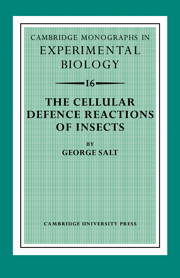Book contents
- Frontmatter
- Contents
- Acknowledgements
- 1 INTRODUCTION
- 2 PHAGOCYTOSIS
- 3 ENCAPSULATION
- 4 NODULE FORMATION
- 5 OBJECTS THAT EXCITE CELLULAR REACTIONS
- 6 THE REACTIONS OF INSECT BLOOD CELLS
- 7 CELLULAR REACTIONS AND IMMUNITY
- 8 A COMPARISON OF INSECT AND VERTEBRATE DEFENCE REACTIONS
- References
- Index of organisms
- Index of subjects
- Plate section
8 - A COMPARISON OF INSECT AND VERTEBRATE DEFENCE REACTIONS
Published online by Cambridge University Press: 20 April 2010
- Frontmatter
- Contents
- Acknowledgements
- 1 INTRODUCTION
- 2 PHAGOCYTOSIS
- 3 ENCAPSULATION
- 4 NODULE FORMATION
- 5 OBJECTS THAT EXCITE CELLULAR REACTIONS
- 6 THE REACTIONS OF INSECT BLOOD CELLS
- 7 CELLULAR REACTIONS AND IMMUNITY
- 8 A COMPARISON OF INSECT AND VERTEBRATE DEFENCE REACTIONS
- References
- Index of organisms
- Index of subjects
- Plate section
Summary
It is scarcely possible at present to compare the defence reactions of insects and vertebrates in any detail. The two fields have been investigated in isolation, and no one has yet mastered both of their separate and rather exclusive literatures. Three interesting attempts have been made by authorities on vertebrate reactions not wholly at home among insects (Good & Papermaster, 1964; Burnet, 1968; Nelson, 1969). The paragraphs that follow are likely to betray ignorance of the complexities of vertebrate reactions. They are written in the belief that there is a pressing need to build abutments from which the gap between the two fields can eventually be bridged.
The most obvious point of difference is that cellular reactions play a relatively larger part in the defence of insects against infection. This may be partly reciprocal, in the sense that the more highly developed humoral reactions of warm-blooded vertebrates leave less for the cellular reactions to do. The difference is magnified, however, because in vertebrates the distinction between cellular and humoral reactions is a good deal blurred, owing to the intervention of opsinins, cytophilic antibodies, lymphokines and the like in their cellular reactions. Among insects there is as yet no evidence for such intervention; so that cellular and humoral reactions remain distinct, and the part played by the former is evident.
Since only the cellular reactions of insects have been reviewed in this monograph, comparison must be restricted to the cellular reactions of vertebrates.
- Type
- Chapter
- Information
- The Cellular Defence Reactions of Insects , pp. 94 - 100Publisher: Cambridge University PressPrint publication year: 1970
- 1
- Cited by

